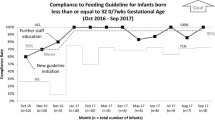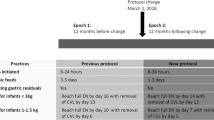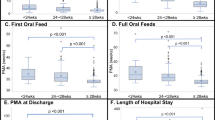Abstract
Objective
The goal of this study was to assess the impact of infant-driven feeding (IDF) compared to traditional feeding protocols in promoting earlier successful feeding outcomes.
Study design
We performed a cross-sectional analysis of infants admitted to a level three neonatal intensive care unit (NICU) over a 2-year period. We compared infants fed with the traditional protocol to those under the IDF protocol.
Results
Infants in the IDF group were younger at first feed (p < 0.001). There was no difference in age at nasogastric (NG) tube removal or at discharge, length of stay, or percentage breastfeeding at discharge. There were no differences in outcomes within two subgroups born at <35 and <32 weeks gestation, respectively.
Conclusion
The IDF program led to earlier initiation of oral feeding. However, this did not lead to earlier NG tube removal or discharge, a shorter length of stay, or increase in the rates of breastfeeding.
This is a preview of subscription content, access via your institution
Access options
Subscribe to this journal
Receive 12 print issues and online access
$259.00 per year
only $21.58 per issue
Buy this article
- Purchase on Springer Link
- Instant access to full article PDF
Prices may be subject to local taxes which are calculated during checkout

Similar content being viewed by others
References
Jadcherla S, Wang M, Vijayapal A, Leuthner S. Impact of prematurity and co-morbidities on feeding milestones in neonates: a retrospective study. J Perinatol. 2009;30:201–8.
Kirk A, Alder S, King J. Risk factors for poor oral feeding progression in premature infants. J Investigative Med. 2006;54:S98.
Park J, Knafl G, Thoyre S, Brandon D. Factors associated with feeding progression in extremely preterm infants. Nurs Res. 2015;64:159–67.
Gelfer P, McCarthy A, Turnage, Spruill C. Infant driven feeding for preterm infants: learning through experience. Newborn Infant Nurs Rev. 2015;15:64–7.
Settle M, Francis K. Does the infant-driven feeding method positively impact preterm infant feeding outcomes? Adv Neonatal Care. 2019;19:51–5.
Underwood MA. Human milk for the premature infant. Pediatr Clin North Am. 2013;60:189–207.
Bu’Lock F, Woolridge MW, Baum JD. Development of co‐ordination of sucking, swallowing and breathing: ultrasound study of term and preterm infants. Developmental Med Child Neurol. 1990;32:669–78.
Weber F, Woolridge MW, Baum JD. An ultrasonographic study of the organisation of sucking and swallowing by newborn infants. Dev Med Child Neurol. 1986;28:19–24. https://doi.org/10.1111/j.1469-8749.1986.tb03825.x.
Paul K, Dittrichová J, Papousek H. Infant feeding behavior: development in patterns and motivation. Dev Psychobiol. 1996;29:563–76. 10.1002/(SICI)1098-2302(199611)29:7<563::AID-DEV2>3.0.CO;2-S.
Whetten CH. Cue-based feeding in the NICU. Nurs Women’s Health. 2016;20:507–10. https://doi.org/10.1016/j.nwh.2016.08.006.
Lau C. Development of oral feeding skills in the preterm infant. Arch Pediatr. 2007;14S35–41. https://doi.org/10.1016/s0929-693x(07)80009-1.
Whyte RK. Neonatal management and safe discharge of late and moderate preterm infants. Semin Fetal Neonatal Med.2012;17:153–8. https://doi.org/10.1016/j.siny.2012.02.004.
Mizuno K, Ueda A. The maturation and coordination of sucking, swallowing, and respiration in preterm infants. J Pediatr. 2003;142:36–4.
Berseth CL. Gastrointestinal motility in the neonate. Clin Perinatol. 1996;23:179–90.
Breton S, Steinwender S. Timing introduction and transition to oral feeding in preterm infants: current trends and practice. Newborn Infant Nurs Rev. 2008;8:153–9.
Shaker CS. Cue-based feeding in the NICU: using the infant’s communication as a guide. Neonatal Netw. 2013;32:404–8.
Newland L, L’huillier MW, Petrey B. Implementation of cue-based feeding in a level III NICU. Neonatal Netw. 2013;32:132–7.
Brown A, Arnott B. Breastfeeding duration and early parenting behaviour: the importance of an infant-led, responsive style. PLoS ONE. 2014;9:e83893. https://doi.org/10.1371/journal.pone.0083893.
Ventura AK, Thompson K. Predictors of resilience among infants at risk for rapid weight gain. Obesity. 2019;27:130–6.
McCain GC, Gartside PS, Greenberg JM, Lott JW. A feeding protocol for healthy preterm infants that shortens time to oral feeding. J Pediatr. 2001;139:374–9.
McCain GC, Moral TD, Duncan RC, Fontaine JL, Pino LD. Transition from gavage to nipple feeding for preterm infants with bronchopulmonary dysplasia. Nurs Res. 2012;61:380.
Kish MZ. Improving preterm infant outcomes: implementing an evidence-based oral feeding advancement protocol in the neonatal intensive care unit. Adv Neonatal Care. 2014;14:346–53.
Watson J, McGuire W. Responsive versus scheduled feeding for preterm infants. Cochrane Database Syst Rev. 2016:CD005255. https://doi.org/10.1002/14651858.
Wellington A, Perlman JM. Infant-driven feeding in premature infants: a quality improvement project. Arch Dis Child Fetal Neonatal Ed. 2015;100:F495–500.
Davidson E, Hinton D, Ryan-Wenger N, Jadcherla S. Quality improvement study of effectiveness of cue-based feeding in infants with bronchopulmonary dysplasia in the neonatal intensive care unit. J Obstet Gynecol Neonatal Nurs. 2013;42:629–40.
Puckett B, Grover VK, Holt T, Sankaran K. Cue-based feeding for preterm infants: a prospective trial. Am J Perinatol. 2008;25:623–8.
Giannì ML, Sannino P, Bezze E, Plevani L, Esposito C, Muscolo S, et al. Usefulness of the infant driven scale in the early identification of preterm infants at risk for delayed oral feeding independency. Early Hum Dev. 2017;115:18–22.
Ludwig S, Waitzman R. Changing feeding documentation to reflect infant-driven feeding practice. Newborn Infant Nurs Rev. 2007;7:155–60.
Fry T, Marfurt S, Wengier S. Systematic review of quality improvement initiatives related to cue-based feeding in preterm infants. Nurs Women’s Health. 2018;22:401–10.
Kirk A, Alder S, King J. Cue-based oral feeding clinical pathway results in earlier attainment of full oral feeding in premature infants. J Perinatol. 2007;27:572–8.
Dalgleish SR, Kostecky LL, Blachly N. Eating in “SINC”: safe individualized nipple-feeding competence, a quality improvement project to explore infant-driven oral feeding for very premature infants requiring noninvasive respiratory support. Neonatal Netw. 2016;35:217–27.
Kong SK, Lee DT. Factors influencing decision to breastfeed. J Adv Nurs. 2004;46:369–379. https://doi.org/10.1111/j.1365-2648.2004.03003.
Arora S, McJunkin C, Wehrer J, Kuhn P. Major factors influencing breastfeeding rates: mother’s perception of father’s attitude and milk supply. Pediatrics. 2000;106:e67. https://doi.org/10.1542/peds.106.5.e67.
Li R, Magadia J, Fein SB, Grummer‐Strawn LM. Risk of bottle‐feeding for rapid weight gain during the first year of life. Arch Pediatr Adolesc Med. 2012;166:436.
Ventura AK. Developmental trajectories of bottle‐feeding during infancy and their association with weight gain. J Dev Behav Pediatr. 2017;38:119.
Chrupcala KA, Edwards TM, Spatz DL. A continuous quality improvement project to implement infant-driven feeding as a standard of practice in the newborn/infant intensive care unit. J Obstet Gynecol Neonatal Nurs. 2015;44:654–64.
American Academy of Pediatrics Committee on Fetus and Newborn. Hospital discharge of the high-risk neonate. Pediatrics. 2008;122:1119–26.
Smith V, Hwang S, Dukhovny D, Young S, Pursley DM. Neonatal intensive care unit discharge preparation, family readiness and infant outcomes: connecting the dots. J Perinatol. 2013;33:415–21.
Brumbaugh J, Colaizy T, Saha S, Van Meurs K, Das A, Walsh M, et al. Oral feeding practices and discharge timing for moderately preterm infants. Early Hum Dev. 2018;120:46–52.
Edwards L, Cotton CM, Smith PB, Goldberg R, Saha S, Das A. et al. Inadequate oral feeding as a barrier to discharge in moderately preterm infants. J Perinatol. 2019;39:1219–28. https://doi.org/10.1038/s41372-019-0422-x.
Crosson DD, Pickler RH. An integrated review of the literature on demand feedings for preterm infants. Adv Neonatal Care. 2004;4:216–25.
Nangia S, Tiwari S. Failure to thrive. Indian J Pediatr. 2013;80:585–9.
Browne JV, Ross ES. Eating as a neurodevelopmental process for high-risk newborns. Clin Perinatol. 2011;38:731–43.
Jung JS, Chang HJ, Kwon JY. Overall profile of a pediatric multidisciplinary feeding clinic. Ann Rehabil Med. 2016;40:692–701. https://doi.org/10.5535/arm.2016.40.4.692.
Acknowledgements
The authors would like to thank the healthcare team involved in selecting and implementing the IDF protocol and sharing electronic medical record information for the relevant patients. There were no sources of support or material to report.
Author information
Authors and Affiliations
Contributions
CBB, WMB, AL, JP, AES, and JRB: involved in study conception and design. AL and JP: involved in data acquisition. JRB and AES: involved in data analysis. CBB, AL, and JP: involved in interpretation of data analysis and first draft of manuscript. CBB, WMB, SFR, AES, and JRB: critical revision of the manuscript. All authors: approved the final manuscript.
Corresponding authors
Ethics declarations
Conflict of interest
The authors declare no competing interests.
Additional information
Publisher’s note Springer Nature remains neutral with regard to jurisdictional claims in published maps and institutional affiliations.
Rights and permissions
About this article
Cite this article
Lane, A., Pacella, J., Beal, J.R. et al. A cross-sectional analysis of infant-driven and traditional feeding outcomes for neonatal intensive care unit infants. J Perinatol 41, 1865–1872 (2021). https://doi.org/10.1038/s41372-021-01084-9
Received:
Revised:
Accepted:
Published:
Issue Date:
DOI: https://doi.org/10.1038/s41372-021-01084-9



